#d1cbd1 Color Information
In a RGB color space, hex #d1cbd1 is composed of 82% red, 79.6% green and 82% blue. Whereas in a CMYK color space, it is composed of 0% cyan, 2.9% magenta, 0% yellow and 18% black. It has a hue angle of 300 degrees, a saturation of 6.1% and a lightness of 80.8%. #d1cbd1 color hex could be obtained by blending #ffffff with #a397a3. Closest websafe color is: #cccccc.
-
- R 82
- G 80
- B 82
-
- C 0
- M 3
- Y 0
- K 18
● #d1cbd1 color description : Grayish magenta.
#d1cbd1 Color Conversion
The hexadecimal color #d1cbd1 has RGB values of R:209, G:203, B:209 and CMYK values of C:0, M:0.03, Y:0, K:0.18. Its decimal value is 13749201.
| Hex triplet | d1cbd1 | #d1cbd1 |
|---|---|---|
| RGB Decimal | 209, 203, 209 | rgb(209,203,209) |
| RGB Percent | 82, 79.6, 82 | rgb(82%,79.6%,82%) |
| CMYK | 0, 3, 0, 18 | |
| HSL | 300°, 6.1, 80.8 | hsl(300,6.1%,80.8%) |
| HSV (or HSB) | 300°, 2.9, 82 | |
| Web Safe | cccccc | #cccccc |
| CIE-LAB | 82.309, 3.153, -2.249 |
|---|---|
| XYZ | 59.157, 60.871, 68.951 |
| xyY | 0.313, 0.322, 60.871 |
| CIE-LCH | 82.309, 3.873, 324.506 |
| CIE-LUV | 82.309, 3.05, -3.961 |
| Hunter-Lab | 78.02, -1.19, 2.216 |
| Binary | 11010001, 11001011, 11010001 |
Color Schemes with #d1cbd1
Alternatives to #d1cbd1
Below, you can see some colors close to #d1cbd1. Having a set of related colors can be useful if you need an inspirational alternative to your original color choice.
#d1cbd1 Preview
This text has a font color of #d1cbd1.
<span style="color:#d1cbd1;">Text here</span>This paragraph has a background color of #d1cbd1.
<p style="background-color:#d1cbd1;">Content here</p>This element has a border color of #d1cbd1.
<div style="border:1px solid #d1cbd1;">Content here</div>.text {color:#d1cbd1;}.background {background-color:#d1cbd1;}.border {border:1px solid #d1cbd1;}Shades and Tints of #d1cbd1
A shade is achieved by adding black to any pure hue, while a tint is created by mixing white to any pure color. In this example, #000000 is the darkest color, while #f6f5f6 is the lightest one.
-
#000000
#000000rgb(0,0,0) -
#0a090a
#0a090argb(10,9,10) -
#151215
#151215rgb(21,18,21) -
#1f1c1f
#1f1c1frgb(31,28,31) -
#2a252a
#2a252argb(42,37,42) -
#342e34
#342e34rgb(52,46,52) -
#3e373e
#3e373ergb(62,55,62) -
#494049
#494049rgb(73,64,73) -
#534a53
#534a53rgb(83,74,83) -
#5e535e
#5e535ergb(94,83,94) -
#685c68
#685c68rgb(104,92,104) -
#736573
#736573rgb(115,101,115) -
#7d6f7d
#7d6f7drgb(125,111,125)
-
#877887
#877887rgb(135,120,135) -
#918291
#918291rgb(145,130,145) -
#9a8d9a
#9a8d9argb(154,141,154) -
#a397a3
#a397a3rgb(163,151,163) -
#aca1ac
#aca1acrgb(172,161,172) -
#b5acb5
#b5acb5rgb(181,172,181) -
#bfb6bf
#bfb6bfrgb(191,182,191) -
#c8c1c8
#c8c1c8rgb(200,193,200) -
#d1cbd1
#d1cbd1rgb(209,203,209) -
#dad5da
#dad5dargb(218,213,218) -
#e3e0e3
#e3e0e3rgb(227,224,227) -
#edeaed
#edeaedrgb(237,234,237) -
#f6f5f6
#f6f5f6rgb(246,245,246)
Tones of #d1cbd1
A tone is produced by adding gray to any pure hue. In this case, #d1cbd1 is the less saturated color, while #fe9efe is the most saturated one.
-
#d1cbd1
#d1cbd1rgb(209,203,209) -
#d5c7d5
#d5c7d5rgb(213,199,213) -
#d9c3d9
#d9c3d9rgb(217,195,217) -
#dcc0dc
#dcc0dcrgb(220,192,220) -
#e0bce0
#e0bce0rgb(224,188,224) -
#e4b8e4
#e4b8e4rgb(228,184,228) -
#e8b4e8
#e8b4e8rgb(232,180,232) -
#ebb1eb
#ebb1ebrgb(235,177,235) -
#efadef
#efadefrgb(239,173,239) -
#f3a9f3
#f3a9f3rgb(243,169,243) -
#f7a5f7
#f7a5f7rgb(247,165,247) -
#faa2fa
#faa2fargb(250,162,250) -
#fe9efe
#fe9efergb(254,158,254)
Color Blindness Simulator
Below, you can see how #d1cbd1 is perceived by people affected by a color vision deficiency. This can be useful if you need to ensure your color combinations are accessible to color-blind users.
